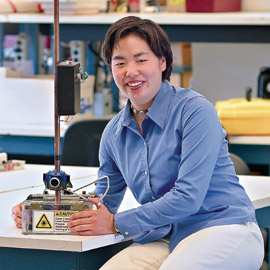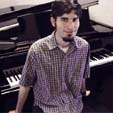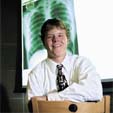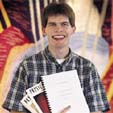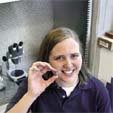 |


|
Summer 2004 | Volume 26, Number 7 | Features |
||||||
| R&D For Undergraduates SPU RESEARCH CONFERENCE SPOTLIGHTS THE NEXT GENERATION OF SCIENTISTS Software that writes music based on a composer’s specifications, research that probes the possible regeneration of human neurons, and lasers designed to measure spatial dimensions at the click of a button. Sound like the latest news from an issue of Popular Science? No, these are all projects designed by Seattle Pacific University students and presented at SPU’s second annual Erickson Undergraduate Research Conference in Science, Technology, Engineering and Mathematics.
Held at Otto Miller Hall, the conference featured undergraduate research posters, prototypes and presentations with intriguing titles such as “Mindstorm Lobotomy” and “Chaotic Pendulum.” The annual event is named for former Dean of the College of Arts and Sciences (CAS) Joyce Quiring Erickson, who retired last year after 25 years of teaching and administration at Seattle Pacific. Before retiring, she helped spearhead the first research conference in 2003. Miller Hall, which houses the disciplines of physics, computer science, electrical engineering and mathematics, recently reopened after a six-month, $5-million renovation. The $26-million new Science Building, located just two blocks away, has housed the disciplines of biology, chemistry, biochemistry and psychology since its dedication in September 2003. Says current CAS Dean Bruce Congdon, “Science at SPU is moving into a new era, not just into new buildings. Our goal is for students not only to learn scientific information, but also to learn how to discover new information themselves and to design new applications. Our undergraduate researchers are the fullest expression of this goal.” Many of the conference presenters were seniors described by their professors as Seattle Pacific’s most outstanding students in the sciences. Five of these seniors, featured here, had majors or double majors ranging from biology to physics, even to music and philosophy. The plans of these new graduates are potentially world-changing. GEOMETRY WITH
LASERS
”Her senior project, developing a model laser-ranging system, was the work of a four-person engineering team nicknamed The Target Practice. Designed to find a target, calculate distance and launch a projectile, the model is equipped with a video camera. Once a target is found, information is displayed on a screen. The model could have military applications for longer distances, but that was not its main purpose, Yoshimura explains: “We built it as an interactive tool for students.” Grade-schoolers studying geometry could direct it around a classroom, measuring distance, angles and lines with lasers. What does she like about the renovation of Miller Hall — previously the Miller Science Learning Center? “There’s a lot more room,” Yoshimura quips. Now that the “wet” sciences of biology, chemistry and biochemistry have transferred to the new Science Building up the street, she says, students in the “dry” sciences can stretch out in Otto Miller. Seniors have their own design lab, and that provides space for teams to work together. “Before the renovation, it was great to share space with other majors and classes,” she acknowledges, “but when you start getting into your design work, you need to have more computers and dedicated work space available.” The Electrical Engineering Department now boasts an optics lab, as well as high-tech equipment donated from local research laboratories. Yoshimura says she can see herself working as a “tentmaker,” combining her professional skills with ministry as Paul did in New Testament days. Specifically, she thinks she might want to work as an engineer in overseas missions. This summer she is taking a step toward that goal, traveling to Africa on a SPRINT (Seattle Pacific Reachout International) team. “We’ll see if God continues to direct me in that path,” she says. SOFTWARE THAT MAKES MUSIC For his senior honors project in the University Scholars program, Myron Marston blended music theory, math and computer science. “I could see connections in the three disciplines,” he says. He created a computer program that writes music based on the composer’s parameters, such as the key, tempo and a phrase of music that the program repeats in a wide range of ways. Marston’s program creates music using fractals, or repeated patterns. “Fractals are like a tree, with every branching similar to every other branching,” he explains. “I had seen fractals in math class and in graphics and wanted to make music with them.” According to his professors, the results sound like true music, not digital experiments. The program’s music resembles a playful cross between the piano fugues of Bach and the instrumental solos of offbeat composer Philip Glass. What Marston enjoyed most about the revamped Miller Hall was “a computer at each desk in computer science class. You have a chance to try out code in class, where you can ask questions, instead of trying to figure it out by yourself after class.” Marston is considering graduate study in music composition. In the meantime, he plans a career in writing software. “I want to combine computers and music,” he says, “both in my job and for fun.” CURBING
TUBERCULOSIS IN RUSSIA Traveling to Russia this fall to “partner with physicians combatting the high incidence of tuberculosis among prisoners,” the new graduate tackles difficult tasks easily. Asked how he will communicate with Russian physicians, he shrugs. “I speak Russian.” On an earlier trip to that country, Henricksen happened to break his arm. A doctor told him about a growing medical problem. Russian prisoners in unsanitary conditions can easily contract a highly antibiotic-resistant form of tuberculosis, which spreads to the main population when the prisoners are released. Henricksen plans to study how treatment is being addressed by world relief agencies. Last summer, a SPRINT (Seattle Pacific Reachout International) trip to South Africa sparked Henricksen’s interest in international medical work and social justice, a combination that he says could become a career: “SPRINT showed me how deeply intertwined the lives of the rich and poor can be. Being in another country made me see how my privileged life comes at the direct expense of the poor.” Henricksen’s professors considered him a mentor to younger students and a “mainstay” in philosophy forums, though he did not declare philosophy as a second major until his senior year. What does philosophy have to do with tuberculosis in Russian prisoners? “Philosophy helps you to figure out what constitutes a good life,” he says. “I think that’s attainable by going out and living for others. Otherwise, I’d feel ambivalent about what’s been given to me.” QUANTUM MECHANICS FOR UNDERGRADS In the renovated Miller Hall, Siirila found his physics lab experiments could be much more precise. Before the building was rebuilt, he says with a laugh, “the upstairs would shake when trucks rolled by outside, and there we were, trying to do measurements.” The retrofitted building is now considered the safest on campus. His plans for the summer and fall? Siirila has a short list of essentials: This summer, he marries Beth Jordan ’04, an English major. And this fall, he tutors inner-city Philadelphia kids with Beth through AmeriCorps, teaching literacy, drama and sports programs. Aaron says he and Beth wanted to put their studies into action, “to use some experience to sharpen ourselves.” Even though Siirila loves school, he admits, “I want to get away to focus before going on to grad school.” He’s not sure what to concentrate in next, though all of his work so far seems to be about teaching young people. “With my project,” he says, “I wanted to find out, ‘How do we teach better? What tools can we use to help?’ Part of my passion is to help people learn.” REGENERATION OF HUMAN NEURONS While at SPU, Matzat became interested in graduate studies in neuroscience and biochemistry. “My goal is to someday have my own research lab,” she says. For Matzat and other biology majors, it was important to look at live cells with the new Science Building’s powerful microscopes. “It’s nice to see the University putting an effort toward undergrad research by providing the facilities for us,” she says. “Even though we’re not a huge school, we have the chance to use electron microscopes and an imaging suite.” It took quite a while for Matzat and others to set up equipment for cell interaction studies in the new labs. But she says it was worth it: “We laid good groundwork for future students to be able to characterize these interactions more.” Matzat found out about Seattle Pacific and its Christian emphasis through a Web search. “From the science end of things, and from the philosophy end of things, it’s a good environment,” she says. “All the speakers who come to talk to students about connections between faith and science — it would be hard to find that kind of forum anywhere else.” — BY MARGARET D. SMITH Back to Home |
|
||||||
